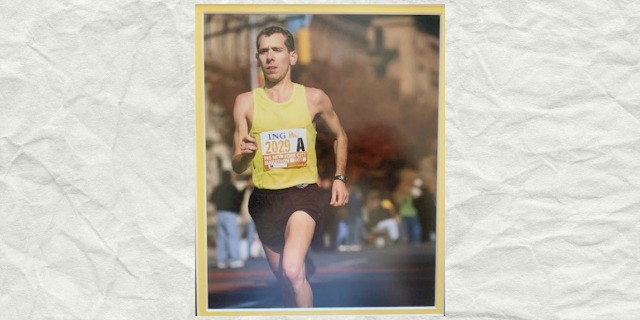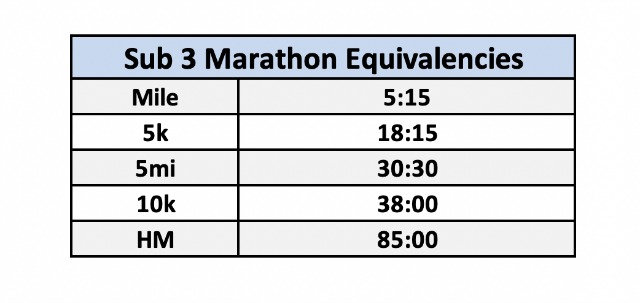So, you want to run a fast marathon? But not any fast time… a sub 3 hour marathon! Here’s how to make it a reality.

Jason winning the 2013 Potomac River Run Marathon
There’s something magical about running a fast marathon. Because of its length, the race is notoriously difficult.
That’s because at marathon-intensity, beyond 20 miles is like the Wild West. You just never know what might happen out there on the race course. The options for disaster seem limitless:
- Muscle cramps
- Side stitches
- The infamous “wall” or marathon bonk
- Heat exhaustion
- Electrolyte imbalance
- GI distress or other tummy troubles
- Low energy from not enough fuel (see how an elite marathoner fuels her diet here)
Most races are too short for these problems to make a meaningful impact on your performance. But over 26.2 miles, problems can compound.
And the faster you run, the worse these problems can become.
That’s why putting together a fast marathon – especially a sub 3 hour marathon finish – is particularly exciting. That fast finish time underscores successful preparation, fueling, and execution for the marathon.
Let’s not also forget that marathoners often put all their eggs in one basket: their singular marathon race. If it goes well, great! But if not, they have to recover, wait, and start the training process all over again.
In other words, there are rarely any “do overs” in marathoning.
For those of you with bold and ambitious marathon goals, this article will help you discover what is actually important when it comes to running a fast marathon.
And if you’d like to set your sights on joining the “2:XX Marathon Club,” this is your 3-step process for becoming a sub 3 hour marathon-caliber runner.
Sub 3 Ingredient #1: Competitive Mileage Levels

The 2014 Boston Marathon. Ouch.
If you have a bold and ambitious race goal – like a sub 3 hour marathon – you’ll need bold and ambitious training.
While most runners are typically training between 20 – 35 miles per week, you’ll need to step up your game.
Not only will higher mileage levels be necessary during your marathon training, but also during the rest of the year. High mileage running is a lifestyle, not something you do occasionally!
And when it comes to your aerobic base, bigger is better.
To make your sub 3 marathon a reality, first make higher mileage running a priority. When you’re comfortable running 40-50 miles per week regularly, you’ll be far more prepared for the rigors of marathon training.
Tempo runs become easier. And long runs – the keystone of marathon preparation – become more manageable as you build endurance and aerobic strength.
Over time, runners who build the capability to run 50+ miles per week (at the minimum) have a better chance of running a sub 3 hour marathon time.
In fact, Strava published data a few years ago demonstrating that those who qualify for the Boston Marathon run more miles. And while a sub-3 is more competitive than a BQ, it shows that higher mileage is even more important for this bolder goal!
Sub 3 Ingredient #2: Consistent Long Runs

Running my PR of 2:39:32 at the 2011 Philadelphia Marathon
To get faster at racing long distances, long distances must be made easy. And that’s done through repetition.
See here to discover what long runs do to the body (you’ll want to do them way more regularly!).
While most marathoners spend their training time gradually building their long run to about 20 miles, more competitive marathoners can’t waste that time building their long run distance. They must spend time practicing it and making those runs more challenging (by incorporating marathon-specific pace work).
The final 6 weeks of marathon training for many runners might include these long run distances:
- 16
- 17
- 18
- 14
- 19
- 20
This progression is fairly aggressive; besides one cutback week, the long run distance increases every week. That could very well cause an injury.
Besides being risky, this long run progression doesn’t include any marathon-specific work and is only 104 miles.
A runner gearing up for a sub 3 hour marathon needs a more ambitious series of long runs:
- 19
- 18: last 4mi @ Goal Marathon Pace
- 20
- 20
- 21
- 20: last 5mi @ Goal Marathon Pace
Over 6 runs, this progression includes 14 more miles and two runs that include goal pace work.
For the runner shooting for a 2:59 marathon, a more substantial progression of long runs is needed to reach their goal. And that’s only possible for runners who have built their capacity for long distances over years.
Sub 3 Ingredient #3: Equivalent Race Performances

My debut at the 2008 NYC Marathon (not so pretty)
A sub 3 hour marathon is quite competitive. If you want to have a shot at achieving this milestone, your other race times must also be quite competitive.
That’s because running is running. Fitness is fitness. And fast runners are fast runners (no matter the distance).
You’ll never run a standout marathon if your other Personal Bests don’t… stand out, too.
This is where the idea of equivalent performances is critical.
To have any shot at breaking 3 in the marathon, you’ll need to run race times in the 5k, 10k, and half marathon that are similar to how competitive a 2:59 marathon is.
Here’s my approximation of the equivalent performances of a sub 3 hour marathon:

It’s ideal to set PR’s in the shorter distances and get as close to these equivalent times as possible before you start running a lot of marathons.
Why? Well, because marathons are hard and shorter races are less so!
- You can run more short races (since the recovery is easier), giving you more opportunities to improve
- The training is more beginner-friendly than high-volume marathon training
- Speed is a skill and should be developed first
Everywhere around the world, beginner runners are introduced to the sport of running through cross country and track and field – not the marathon.
That’s very instructive: it shows us that we should develop the skills of power, coordination, speed, agility, and overall athleticism before focusing exclusively on high-level endurance.
Case Study: How I Broke 3 in My Debut Marathon
Looking back, I debuted at the marathon distance with a 2:44:38 finish. But I had already been running for over a decade with experience running 90 miles per week, regular long runs of 15-18 miles, and a slew of personal bests more competitive than a 2:44 marathon:
- 4:33 in the mile
- 54:50 for 10 miles
- 1:13:39 for the half marathon
In hindsight, of course I was ready to run a sub 3 hour marathon! Anybody who has run these times has the ability to run a sub-3. It just takes a bit more training.
And that’s exactly where you want to get yourself: to a position where it’s virtually guaranteed to run a marathon that fast. Get the training on track first and then focus on getting faster in the 5k, 10k, HM, and other distances.
This is more effective than only running marathons, which is riskier (the injury potential is much higher) and less effective (you’ll never get equivalent performances and why limit yourself only to marathon training?).
A Sub 3 Hour Marathon Requires Caution
Breaking the 3 hour mark in the marathon is an audacious, highly competitive goal for any runner. If successful, you’ll join an elite club with many perks:
- Automatic entry to the first corral at any major marathon
- Confetti, a live band, and a champagne toast at the finish line
- High-fives from every other sub 3 marathoner at the race
Actually, none of that is true. Nobody will really notice except your die-hard friends and family – but that doesn’t mean it’s a goal not worthy of pursuing!
It just takes a long-term approach, patience, and a focus on the process of training. These lofty marathon goals aren’t achieved in a few months but rather years and years. Don’t rush your development!
In our new sub 3 marathon video, I summarize many of the key points in this article:
To help you achieve your heroic marathon goals – whether that’s a sub 3 hour attempt or any other time goal – we have a lot of resources available.
If you have a history of injuries, getting healthy is the first step. Start here!
If you’re healthy, running well, and ready to take a big step forward, start here!
Or if you’re not sure where to start, start here. I’m happy to help.
The results from the Strength Running community are powerful:
“Since following your methods, I am now running injury free with volume of around 50 miles/week with long runs in the 16 mile range. My pace is now slowly increasing. I know that as long as I stay patient and take the time to work on strength, I will be able to progress toward my goal of running my first marathon at age 60 (with a goal of a sub 4 hour time). Thanks again.” – Charles
““Hi Jason, only 2 months ago I could not run 2k. Bad episode of acute ITBS that has been with me for as long as I can remember. This weekend I ran 18k in a balmy 0 degrees without any issues. Your program made it possible. Thanks to you I’m back on track for my Boston Marathon 2018!” – Remko
“I was at the end of my rope after suffering from ongoing ITBS, runner’s knee, hip pain, ankle pain… I love running but I couldn’t do more with risking more injury.
Then I purchased the program and OMG – the injuries have stopped. Even though it’s been almost 4 months now, I’m almost afraid to say it out loud. I simply expect to have knee pain all of time. But I don’t.
Get this! I’m am now running 30-35 miles per week and training for a marathon. And I’m not only running more miles and longer distances, I’m actually running faster. I ran 16 miles on Sunday in 2:16:21 – or 8:31/mi pace. Just five months ago I was running 5 miles at a 9:30/mi pace. Unbelievable. Thanks so much. I look forward to doing more with you in the coming year.” – Tim
No matter what time you run in the marathon, you deserve to train appropriately and achieve your best. Prepare intelligently, stay patient, and always prioritize the process.
See what we can do for you here.
Sooner or later, you might just surprise yourself at what you’re capable of over 26.2 miles.